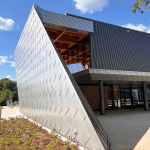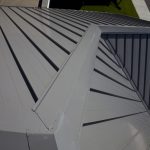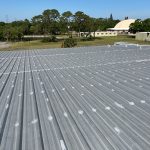Constructing a building on an empty lot has enough challenges as it is. But what happens when you try to build a building in the middle of an urban area, where there are buildings already present? Known as infill construction, the urban environment can bring about a new set of challenges.
Tips for working on a tight site in the middle of an urban area

As with any construction project, a lot of planning goes into the project before the building even starts. For infill construction projects, Brian D. Gaudiano, vice president of Fairchance Construction Co., Fairchance, Pa., says a full site assessment is required, including the constraints of the work area, jurisdictional requirements, lay down area, parking, a survey of adjacent structures, as well as photos of the existing conditions.
In the case of an infill project being an addition or expansion, Nick Walby, special accounts group manager at Walbridge, Ohio-based Rudolph Libbe Inc., part of the Rudolph Libbe Group, says it is important to anticipate how construction can affect the owner’s day-to-day operations and address any potential safety issues, obstructions and interruptions. “For example, we evaluate access to the site, and take that into consideration as we choose equipment and construction methods. Our goal is to be safe, efficient and have zero or minimal impact on the owner’s operations.”
Construction Challenges
Walby goes on to say, that with these types of infill projects, they are typically working around a customer’s ongoing operations and possibly tasks being performed by other contractors on-site. “We work closely with the customer to learn everything we can about what is happening on-site, and we use that information to plan our work and anticipate issues,” he adds.
Unlike building on an empty site, Gaudiano notes that an urban infill site means there are two existing buildings that act as control points for the structure being built. “This is unique and presents many challenges that aren’t present on typical projects,” he says. “Each one of those object’s dimensions are extremely important and are the controlling factors that drive the design and construction of the infill project. You have to consider the horizontal and vertical dimensions, at which you are attaching to each adjacent structure. These dimensions can vary at any given point across the exiting structures surface area. Planning for this is critical to ensure that you fit in between each static structure. This isn’t an issue on standard construction projects because you aren’t typically building anything between two static objects.”
With an infill construction project, builders and contractors will also need to block off streets and sidewalks to keep people safe and away from the building site. At a minimum, Gaudiano says a construction fence should be installed at the perimeter for the work area, which also helps keep material and equipment on the job site. “Most times sidewalks will need to blocked off or have a work platform built above them for safety and work access,” he adds.
“The site location and traffic patterns determine where we place fencing, barricades and signage,” Walby says. “We work closely with the owner and local government officials to anticipate and address any safety issues.”
Make sure you know the local requirements for shutting down sidewalks and streets, and for how long they can be shut down. “Consider the logistical challenges of parking, deliveries, stockpiling material, equipment types and usage,” Gaudiano explains. “Hire a superintendent that has experience in working on urban infill projects or utilize one that is great at scheduling and public relations. Sometimes a little PR goes a long way in dealing with the varied personalities that make an infill project successful. Ensure that your major trades/ sub-contractors have experience in the particular project you are chasing. Especially the concrete, steel and exterior finish trades.”

Tolco Corp.’s first purpose-built addition and largest-ever expansion, a 17,000-square-foot Varco Pruden pre-engineered steel warehouse in Toledo, Ohio.
Photo: Rick Luettke Photography/Luettkestudio.com; courtesy of Rudolph Libbe Inc.
Materials and Equipment
With a tight site and limited space, scheduling of deliveries is important. “We plan our material delivery needs into the project schedule,” Walby says. “This is essential for just-in-time delivery. To have a well-organized site, you want materials to arrive on-site just before they are needed.”
If there’s no way to avoid impacting an owner’s operations, Walby says it’s imperative to give the owner plenty of notice, while committing to—and meeting—the timeframe for completing those tasks.
Gaudiano adds that as the laydown and stock areas on-site decrease, the importance of scheduling materials correctly rises. “It is also more important as the trades overlap and the work is tying into adjacent properties,” he says. “You now have scheduling of not only the project’s trades, but involvement of other property owners, the city or local jurisdiction, considerations of the public and how they are impacted, safety of the workers and pedestrians, etc.”
“You also need to carefully stage materials on-site so they are protected and work can continue safely around them until they are needed,” Walby adds. If materials need to be stockpiled, Gaudiano says other materials need to be out of the way. “There isn’t typically room to keep much on-site,” he says, “outside of the area where it’s being installed.”
A job site with a small footprint and limited work area may require different types of cranes, lifts and scaffolding than a construction project on an open site. “When a project has tight access, smaller equipment may be needed or larger equipment with a longer reach may work best,” Walby explains. “We plan our equipment needs well in advance so the project runs smoothly.”
Tips for a Successful Project
Urban infill construction projects are more challenging than your average build. According to Gaudiano, good, thorough planning by both the contractor and the design team is key. “If the project is design-bid-build, make sure the architect and engineers have done their homework,” he recommends. “If they have missed anything, or miscalculated anything, the results could be disastrous for all parties. Ensure your project team has a thorough understanding of all of the variables involved with the surrounding properties. Take a lot of pictures and document the steps you’ve taken to ensure the safety of the areas surrounding the project. These projects are litigation waiting to happen, but if you are thorough in your processes, you will be successful.”





